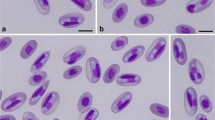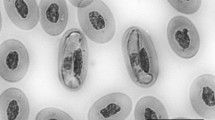Abstract
Hepatozoon aegypti Bashtar, Boulos & Mehlhorn, 1984 was first described from the blood of the diadem snake (Spalerosophis diadema) in Egypt. During an investigation of the diversity of reptilian haemogregarines in Saudi Arabia, seven diadem snakes (100% of the sample) were found to be highly parasitised by H. aegypti, with an average parasitaemia of 37% per 500 counted erythrocytes. A complete characterisation of this species with morphometrics and 18S rDNA sequence data is therefore presented here. The infection was found to be restricted to the erythrocytes with, frequently, single and, sometimes, double infections. Mature gamonts were sausage-shaped with round posterior and anterior extremities and measured 14 (13–17) × 3.5 (3–5) μm. The infected erythrocytes were hypertrophied with a faintly stained cytoplasm and longitudinally stretched nuclei. The merogonic stages occurred only in the endothelial cells of the snakes’ lungs, and no stages were found in other organs. Mature meronts were round in shape, measured 18 (17–21) μm in diameter and were estimated to produce between 9 and 15 merozoites. Phylogenetic analysis based on the partial 18S small subunit ribosomal DNA sequences indicates that Hepatozoon aegypti cluster within a mixed clade of Hepatozoon species parasitising snakes, geckos and rodents from various geographic areas. Our results might reinforce the theory of prey-predator transmission in respect to the relationships of snake-host Hepatozoon species.



Similar content being viewed by others
References
Abdel-Baki AS, Al-Quraishy S (2012) Morphological characteristics of a new species of sAcanthodactylus boskianus (Daudin) (Sauria: Lacertidae) in Egypt. Syst Parasitol 82:65–69
Abdel-Baki AS, Al-Quraishy S, Zhang JY (2014) Redescription of Haemogregarina garnhami (Apicomplexa: Adeleorina) from the blood of Psammophis schokari (Serpentes: Colubridae) as Hepatozoon garnhami n. Comb. based on molecular, morphometric and morphologic characters. Acta Parasitol 59:294–300
Abdel-Haleem HM, Al-Quraishy S, Abdel-Baki AS (2013) A redescription of Haemogregarina damiettae Ramadan et al. 1996 naturally infecting the Acanthodactylus boskianus from Egypt, with new merognic data. Parasitol Res 112:2045–2048
Alhaboubi AR, Pollard DA, Holman PJ (2017) Molecular and morphological characterization of a haemogregarine in the alligator snapping turtle, Macrochelys temminckii (Testudines: Chelydridae). Parasitol Res 116:207–215
Al-Hoot AA (2008) Blood and lung stages of Haemogregarina sp. naturally infecting the snake Spalerosophis diadema cliffordi in Saudi Arabia with reference to its pathogenic effects on the host. Egypt J Zool 51:127–142
Altschul SF, Madden TL, Schäffer AA, Zhang J, Zhang Z, Miller W, Lipman DJ (1997) Gapped BLAST and PSI-BLAST: a new generation of protein database search programs. Nucleic Acids Res 25:3389–3402
Bashtar A-R, Boulos R, Mehlhorn H (1984) Hepatozoon aegypti nov. sp 1 Life cycle. Z Parasitenkd 70:29–41
Darriba D, Taboada GL, Doallo R, Posada D (2012) jModelTest 2: more models, new heuristics and parallel computing. Nat Methods 9:772
Dvořáková N, Kvičerová J, Hostovský M, Široký P (2015) Haemogregarines of freshwater turtles from Southeast Asia with a description of Haemogregarina sacaliae n. Sp. and a redescription of Haemogregarina pellegrini Laveran and Pettit, 1910. Parasitology 142:816–826
Dvořáková N, Kvičerová J, Papoušek I, Javanbakht H, Tiar G, Kami H, Široký P (2014) Haemogregarines from western Palaearctic freshwater turtles (genera Emys, Mauremys) are conspecific with Haemogregarina stepanowi Danilewsky, 1885. Parasitology 141:522–530
Ghai RR, Chapman CA (2012) Meet the parasites: genetic approaches uncover new insights in parasitology. Taprobanica 4:60–64
Hall TA (1999) BioEdit: a user-friendly biological sequence alignment editor and analysis program for windows 95/98/ NT. Nucleic Acids Symp Ser 41:95–98
Han H, Wu Y, Dong H, Zhu S, Li L, Zhao Q, Wu D, Pei E, Wang Y, Huang B (2015) First report of Hepatozoon (Apicomplexa: Adeleorina) from king ratsnakes (Elaphe carinata) in shanghai, with description of a new species. Acta Parasitol 60:266–274
Kumar S, Stecher G, Tamura K (2016) MEGA7: molecular evolutionary genetics analysis version 7.0 for bigger datasets. Mol Biol Evol 33:1870–1874
Larkin MA, Blackshields G, Brown NP, Chenna R, McGettigan PA, McWilliam H, Valentin F, Wallace IM, Wilm A, Lopez R, Thompson JD, Gibson TJ, Higgins DG (2007) Clustal W and Clustal X version 2.0. Bioinformatics 23:2947–2948
Levine ND (1982) Some corrections in haemogregarine (Apicomplexa: protozoa) nomenclature. J Protozool 29:601–603
Lv Z, Wu Z, Zhang L, Ji P, Cai Y, Luo S, Wang H, Li H (2015) Genome mining offers a new starting point for parasitology research. Parasitol Res 114:399–409
Maia JP, Crottini A, Harris DJ (2014) Microscopic and molecular characterization of Hepatozoon domerguei (Apicomplexa) and Foleyella furcata (Nematoda) in wild endemic reptiles from Madagascar. Parasite 21:47
Maia JP, Harris DJ, Perera CA (2011) Molecular survey of Hepatozoon species in lizards from North Africa. J Parasitol 97:513–517
Moço TC, da Silva RJ, Madeira NG, Dos Santos Paduan K, Rubini AS, Leal DD, O'Dwyer LH (2012) Morphological, morphometric, and molecular characterization of Hepatozoon spp. (Apicomplexa, Hepatozoidae) from naturally infected Caudisona durissa terrifica (Serpentes, Viperidae). Parasitol Res 110:1393–1401
Moço TC, O'Dwyer LH, Vilela FC, Barrella TH, da Silva RJ (2002) Morphologic and morphometric analysis of Hepatozoon spp. (Apicomplexa, Hepatozoidae) of snakes. Mem Inst Oswaldo Cruz 97:1169–1176
Perkins SL, Keller AK (2001) Phylogeny of nuclear small subunit rRNA genes of hemogregarines amplified with specific primers. J Parasitol 87:870–876
Ronquist F, Teslenko M, van der Mark P, Ayres DL, Darling A, Höhna S, Larget B, Liu L, Suchard MA, Huelsenbeck JP (2012) MrBayes 3.2: efficient Bayesian phylogenetic inference and model choice across a large model space. Syst Biol 61:539–542
Sloboda M, Kamler M, Bulantová J, Votýpka J, Modrý D (2007) A new species of Hepatozoon (Apicomplexa: Adeleorina) from Python regius (Serpentes: Pythonidae) and its experimental transmission by a mosquito vector. J Parasitol 93:1189–1198
Smith TG (1996) The genus Hepatozoon (Apicomplexa: Adeleina). J Parasitol 82:565–585
Telford SR (2009) Hemoparasites of the Reptilia: color atlas and text. CRC press, Taylor and Francis group, Boca Raton, p 394
Telford SR Jr, Norton TM, Moler PE, Jensen JB (2009) A new Haemogregarina species of the alligator snapping turtle, Macrochelys temminckii (Testudines: Chelydridae), in Georgia and Florida that produces macromeronts in circulating erythrocytes. J Parasitol 95:208–214
Tomé B, Maia JP, Harris DJ (2012) Hepatozoon infection prevalence in four snake genera: influence of diet, prey parasitemia levels, or parasite type? J Parasitol 98:913–917
Tomé B, Maia JP, Salvi D, Brito JC, Carretero MA, Perera A, Meimberg H, Harris DJ (2014) Patterns of genetic diversity in Hepatozoon spp. infecting snakes from North Africa and the Mediterranean Basin. Syst Parasitol 87:249–258
Tomé B, Rato C, Harris DJ, Perera A (2016) High diversity of Hepatozoon spp. in geckos of the genus Tarentola. J Parasitol 102:476–480
Ujvari B, Madsen T, Olsson M (2004) High prevalence of Hepatozoon spp. (Apicomplexa, Hepatozoidae) infection in water pythons (Liasis fuscus) from tropical Australia. J Parasitol 90:670–672
Acknowledgements
We extend our appreciation to the Dean of Scientific Research, King Saud University, for funding the work through the research group project number RGP-004.
Author information
Authors and Affiliations
Corresponding author
Ethics declarations
Conflict of interest
The authors declare that they have no conflict of interest.
Additional information
Section Editor: Leonhard Schnittger
Rights and permissions
About this article
Cite this article
Abdel-Haleem, H.M., Mansour, L., Holal, M. et al. Molecular characterisation of Hepatozoon aegypti Bashtar, Boulos & Mehlhorn, 1984 parasitising the blood of Spalerosophis diadema (Serpentes: Colubridae). Parasitol Res 117, 3119–3125 (2018). https://doi.org/10.1007/s00436-018-6006-4
Received:
Accepted:
Published:
Issue Date:
DOI: https://doi.org/10.1007/s00436-018-6006-4




